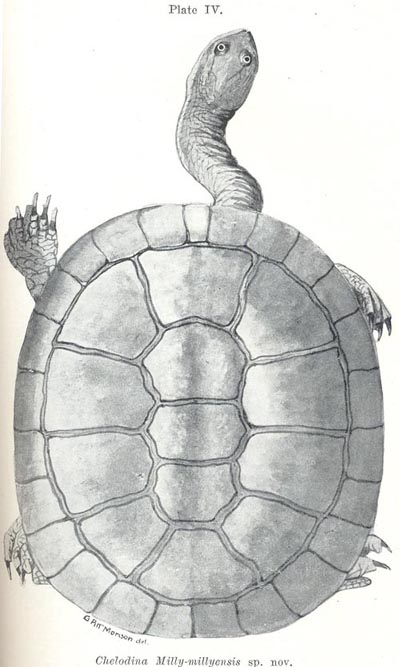Steindachner's Snake-necked Turtle -- Chelodina steindachneri
[2]
 The
English translation of the description by Siebenrock (1914):
The
English translation of the description by Siebenrock (1914):
The w. M. Councillor to the Court Franz Steidachner submits a provisional report of Curator F. Siebenrock, called: A new Chelodina - species from Western Australia.
Chelodina steindachneri sp. n.
Four specimens from Marloo station on the Grey River in Western Australia; sent by Dr. P. Krefft of Lokstedt near Hamburg, to the herpetological collection of the museum director, Councillor to the Court, Mr. Steindachner.
Length of dorsal shell of the largest specimen 184 mm, breadth 159 mm, depth of shell 41 mm; these measurements are in proportion of 89 : 80: 23 in the smallest specimen.
Dorsal shell nearly circular, very flat, plate shaped, rounded all around, laterally not narrowed, in front as wide as the rear. A deep dorsal furrow extends from the second to the fourth vertebrae; shields strongly crinkled. First vertebral shield is wider than second, second and third wider than long, but narrower than the respective costal. Supracaudals joining flatly, wider than the adjacent eleventh marginal. The fourth to sixth marginals unusually wide, not twice as long as wide.
Plastron small, forelobe markedly narrower than the anterior part of the dorsal shell and only somewhat wider than the hind lobe. Bridge notably flat, its angle with the plastron blunt. Anal shields small, laterally concave and at the posterior end protruding in a pointed angle. Anal seam only little longer than the femoral, but much longer than pectoral.
Head long and narrow, snout protruding; interorbital area as wide as the lower jaw symphisis. Neck above and laterally not covered with tubercles, but rather the skin is divided as at the temples by furrows into numerous pads. Only three wide transverse lamellae on the frontal surface of the foreleg. Tubercles on the hind surface of the thigh insignificant and fewer in number.
Dorsal shell light olive and mixed with yellow; plastron straw yellow with brown seams; Head olive green on top, below as well as the neck light ochre. Neck light brown on top, below laterally light ochre.
This species is closely related to Chelodina novae-guineae Blgr
-----
In 1922, Ludwig Glauert (1879 - 1963), eight years after Siebenrock described the species, collected two specimens of C. steindachneri at Milly Milly Station, Murchison River, Western Australia. Glauert worked as a keeper and later in his life as a director of the Western Australian Museum. Unaware of Siebenrock's description, he described the species as Chelodina milly-millyensis in 1922.
Photo: Drawing of Chelodina steindachneri by Pitt Morison featured in Glauert 1922
Glauert's (1922) original description of Chelodina milly-millyensis:
CONTRIBUTIONS TO THE FAUNA OF WESTERN AUSTRALIA.
No. 2.
A New Freshwater Tortoise from the Murchison River.
By L. Glauert, F.G.S.; Western Australian Museum, Perth.
Communicated by permission of the Trustees.
Read: 11th July, 1922.
During my visit to Milly Milly Station, Murchison River, a few months ago as the guest of Mr. D. Mulcahy, I collected two specimens of the Long-necked Tortoise inhabiting Milly Milly Creek
The two carapaces indicated that the animals differed considerably from the known Western Australian Chelodina oblonga, and suggested that I had discovered a new species. Efforts were therefore made to capture living examples, unfortunately without success, and I had to return to Perth without a perfect specimen.
Friends at the Homestead have subsequently forwarded two living tortoises, the larger of which, R1000, is described in this paper.
